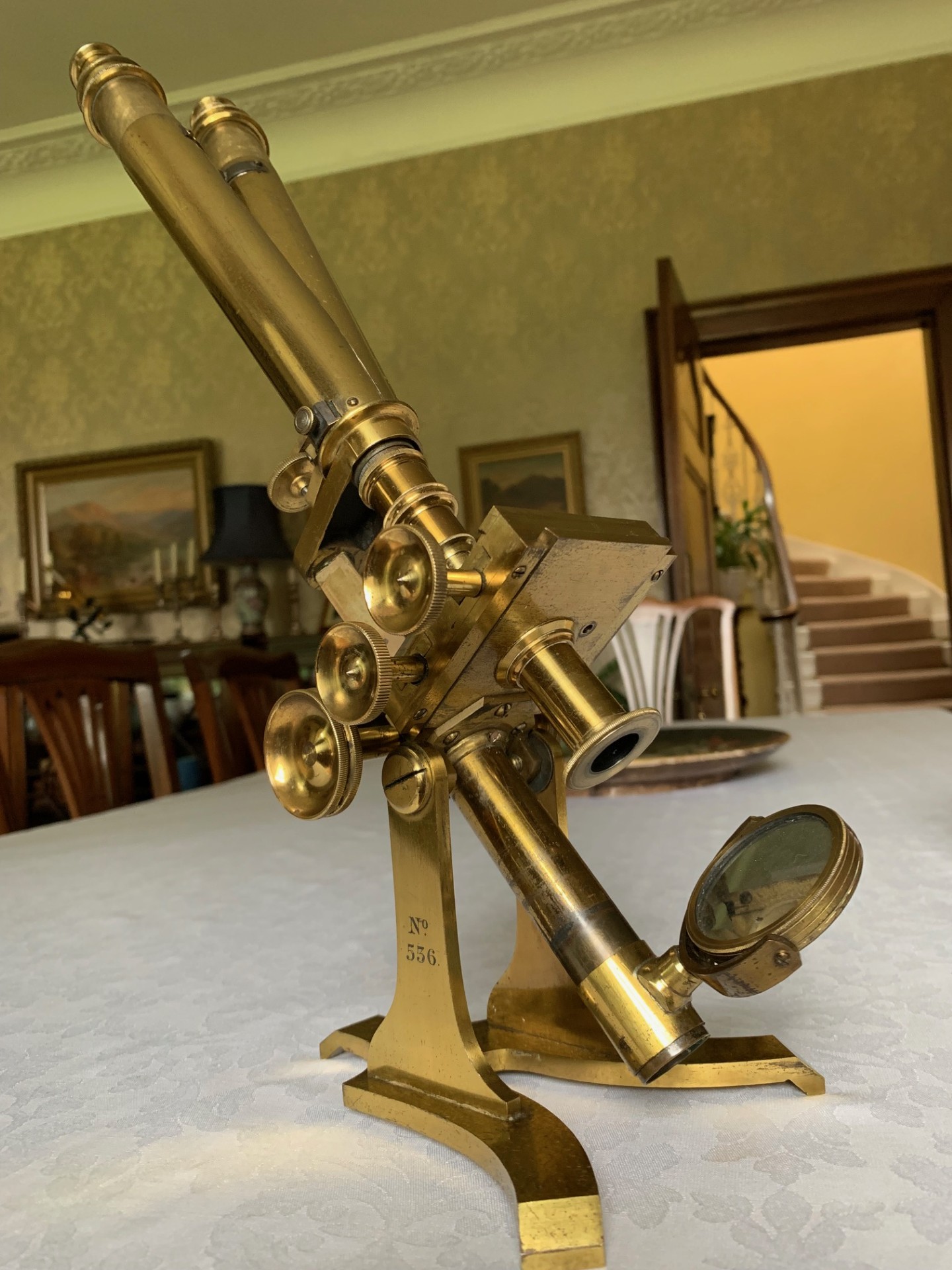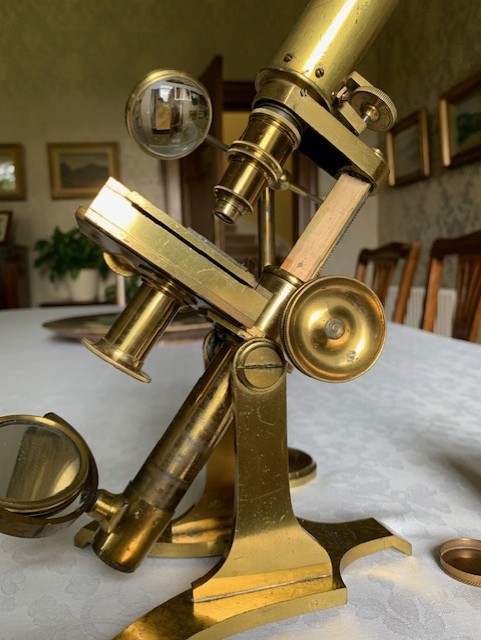SOLD – Antique J H Steward Wenham Binocular Bar-limb Polarising Brass Microscope c1870
Sold
Antique condition collectable and quite rare Wenham binocular bar-limb microscope by scientific instrument maker J H Steward of London with polarising hardware.
Circa
1870
Maker
J H Steward
Country of manufacture
UK and Ireland
Description
This Wenham binocular example bearing production no. 536 would have been produced during the 1870s. It’s a bar-limb design as originally popularised by Andrew Ross in the 1840s. It’s fitted with binocular tubes, a y-shaped foot, twin uprights, horizontal coarse focus rack, mechanical stage and the older style nose-piece fine focus mechanism. It pre-dates the introduction of helical-cut coarse focus rack and pinion mechanisms, which were pioneered by James Powell Swift in the early 1880s and therefore my conclusion based on the foregoing points is that this example will date to sometime during the late 1860s or more likely into the 1870s. It has an elegant design of good proportion, with the Y-shaped foot giving stability and together with the Wenham tubes, the instrument has quite an imposing presence.
This Victorian instrument is in pretty well original condition and also benefits from some original optics, polarising hardware and a fully mechanical stage. It presents really quite well with some gleaming brass-work details, only light tarnishing, and is quite tall, extending to over 18 inches high when fully racked out. It’s got lacquered brass-work including its main tube and thumb-wheels which are showing only a few lacquer losses, which is what you’d hope to see in an instrument that’s been well looked after over the last 150 years or so. The brass-work really glints with a deep golden glow when its catches the light and I hope that the listing photos do this instrument justice, showcasing its excellent visual appeal and collect-ability.
In terms of its technical details, the instrument’s main coarse focus is by rack and pinion, which is an older profile type of rack with horizontal cut, which has a reasonably smooth action throughout its working range and the main tube holds in position as it should on adjustment. Fine focus is achieved via a small brass thumb-wheel located at the rear on the bar, being a vernier screw acting on the nose-piece mechanism only and also has a smooth operation working well. In terms of its optics, this microscope is of the Wenham binocular pattern, with manually operated inter-ocular adjustment requiring individual movement/aligning of the eyepiece draw-tubes. It’s fitted with a pair of approx 6x magnification top-hat style eyepieces that with good illumination produce acceptable bright images. The Wenham prism for this instrument is present in its cage holder/slider and provides a decent binocular image when everything is correctly positioned/optimally aligned along with good bright illumination, which takes a little practice and patience to get just right.
Note on the Wenham prism binocular system:
The Wenham prism for this instrument seems to work quite well with both supplied objectives when the prism cage isn’t fully pushed in. The effect of this technique seems to combine two partial images into one coherent binocular image at the eyepieces. Apparently, according to the Quekett paper I have on the evolution of binocular systems, this is quite normal for the Wenham binocular system. I can supply a copy of the Quekett paper as a PDF should the buyer be interested in the technical aspects of this binocular system.
There are two period objective lenses which screw directly into the optical tube and it’s pleasing to note that Steward used RMS thread for this model, so there’s plenty of objectives available by other makers that can be used with this instrument. The supplied objectives are as follows:
– 3/2 inches Achromatic – 4x magnification
– 2/3rds inch – 10x magnification
(the objectives have their correct brass canisters)
There’s also a nicol prism analyser (shown fitted in the listing photos) that can be fitted to the optical tube for polarised light work in conjunction with the sub-stage polariser mentioned later in the listing.
The magnification currently available will be about 24x to 60x with the optics supplied.
The instrument tilts for inclined viewing and holds in position through the usable part of its inclination range and can be tightened further as necessary. The all-brass specimen stage is a nice feature, being fully mechanical with x/y adjusters on the right-hand side of the stage that have a smooth movement, that also hold in position on inclination.
Turning to the sub-stage, we have a screw-fit brass mount that can be fitted with a plug-in condensing lens, or it can be fitted with a sub-stage polariser. There’s a threaded aperture to fit the nicol prism polariser – shown fitted in the listing photos. Analyser and polariser have been checked and achieve extinction easily on rotation. You will see in the listing photos that there’s a thin section mineral sample on the stage being studied using polarised light.
Lighting is via a plano-concave mirror in a brass mount with intact silvering to both sides and reflectivity that’s fine. The mirror sits on a height adjustable sliding mount on a brass support rod with gimbal giving a good range of adjustment.
Accessories:
– nicol prism analyser
– nicol prism polariser
– plug-in sub-stage condensing lens
– free-standing bull’s-eye condenser
– pair of eyepiece dust covers in brass
The instrument has been sensitively cleaned without disturbing any age-related patination and also lightly lubricated with non-hardening grease, so that the controls operate smoothly. This example displays really well and will make a great display piece, perhaps in the right library or home office type of setting. This is therefore a good visual example of a rare, early and rather elegant J H Steward binocular model in highly original condition with optics usable in both monocular and binocular modes, with polarising capabilities – it’s essentially a collectable proposition and a great display piece as presented. It’s probably of interest to collectors with a gap in their collection for an early and fairly rare-to-market brass example of a bar-limb Wenham binocular by a good quality lesser-known London maker.
There’s currently no storage case with this instrument.
Owing to the weight and delicacy of this antique microscope, it will be partially dismantled, carefully wrapped for shipping and dispatched by insured courier upon receipt of cleared funds.
Ask the Dealer
Dealer information
 Arcboutant Scientific
Arcboutant Scientific
Howard Nutton based in Glasgow Scotland with a background in Natural Science along with previous career in risk management. I obtained my first antique microscope in 1988 - it was a Watson Edinburgh model H serial number 23604 - dating it to 1918. Since that time I've owned and restored hundreds of similar instruments. As Arcboutant Scientific now also making available personally curated fine examples, principally of antique microscopes and associated scientific equipment by quality English and Continental makers, to collectors world-wide.




























